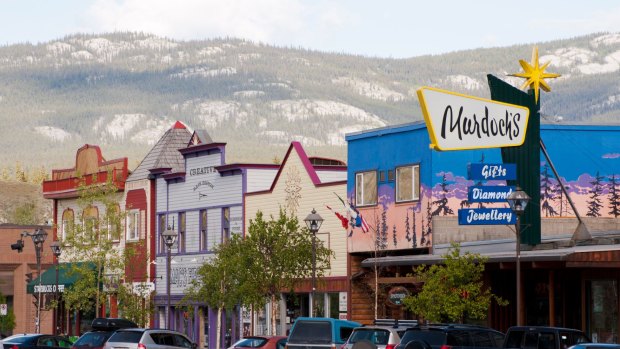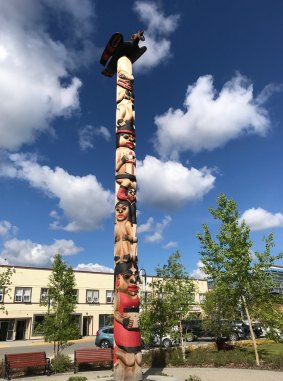This was published 6 years ago
Yukon, Canada: Locals celebrate their harsh Arctic winter
By Julie Miller

Main Street, Whitehorse, Yukon Territory.Credit: Alamy
Living in a sun-drenched country, it's hard to fathom the concept of an Arctic winter – perpetual darkness and sub-zero temperatures for months on end. But for the good folk of the Canadian territory of Yukon, an average of 4½ hours of dim light during the winter solstice and brutal brain-freezing temperatures as low as minus 60 degrees are no reason for hibernation; instead, these tough northerners celebrate the extremes, enjoying winter festivities and channelling their energy into creative pursuits during the long, dark days.
In fact, Yukon boasts twice the national average of artists per capita, with a vibrant arts scene belying its reputation as purely an adventure destination. In the capital of Whitehorse – a city of just 29,000 residents – there are galleries galore, a trail of public art installations, several artists' collectives, a strong indigenous art scene and a healthy performing arts calendar, with the city attracting creative types like moths to a flame.
"Being involved in the arts helps get us through winter," renowned sculptor and printmaker Joyce Majiski, from Yukon Artists@Work, a cooperative and fine art gallery representing around 20 local artists, tells me.

Friendship totem pole in the Rotary Peace Park, Whitehorse.Credit: Julie Miller
"We're surrounded by nature here in Whitehorse, and the Yukon light is amazing – it's all great inspiration," Majiski says. "Most importantly, it's such a supportive community – artists get subsidised rents, and there are grants available at both local and national levels."
For visitors to the quirky gateway to Canada's great north, governmental support of the arts is immediately evident, from a series of Yukon Tourism flags featuring local artists' designs that flutter gaily along the highway, to murals covering bus shelters and sides of buildings, to bicycle racks in the shape of horses – white ones, of course.
A dedicated Art Walk created by the Yukon Historical & Museums Association winds along the waterfront of the Yukon River, leading past a First Nations totem pole, modern and traditional sculptures and even a graffiti-strewn skateboard park, where the gritty scrawls of youth are celebrated rather than decried.
There are also several installations in Shipyards Park, including a series of phallic wood and metal posts created by Joyce Majiski, her connection to the environment evident in metal cutouts and mosaic tiles representing animal tracks and human footprints.
Perched on a hill outside an emergency services building is the unofficial emblem of the city – a massive sculpture of a rearing white horse, lording over the river whose frothing rapids resembling the roiling manes of galloping horses gave the city its name.
Created by local artist Daphne Mennell in 2011, this beautiful, kinetic sculpture is made from junk metal donated by Yukoners, with each piece having its own story and providing a snapshot of community memories. As the artist explains on her website, it's a "public art piece made possible by the public", with the people who donated the metal embracing the sculpture as their own.
Meanwhile, the indigenous people of the north are given their own voice at Adaka, a cultural festival held in the first week of July at the impressive Kwanlin Dun Cultural Centre on the Yukon riverfront. Featuring music, dance, visual arts and traditional crafts such as boatbuilding, beading, moccasin making and wood carving, Adaka – which means "coming into the light" in the Southern Tutchone language – showcases the artistic contributions of Yukon's First Nation tribes, with workshops and displays helping to preserve the traditional way of life.
Outside a white marquee erected on the banks of the Yukon River, I watch, fascinated, as Doug Smarch jnr, of the Kukhhittan (Raven) Clan in Teslin, scrapes and trims a moose hide, one of 14 that will form the lining of a traditional canoe, to be launched as part of Canada's 150-year celebrations.
It's tedious, smelly work under the perpetual midnight sun; but as sweat drips down Doug's nose, he explains how no part of the moose skin is wasted in the boat-building process, with the sinew used as thread and the fat used to reseal seams during future river journeys.
"This is living history, creating the stories of our people, keeping our identity," Smarch says. "It's art, and it's nature. And that's the Yukon for you."
TRIP NOTES
FLY
Air Canada flies from Sydney and Melbourne daily to Vancouver, with domestic connections to Whitehorse in the Yukon. See aircanada.com
STAY
Days Inn Whitehorse has rooms from $CA119 per night. See daysinn.com.ca
Sign up for the Traveller Deals newsletter
Get exclusive travel deals delivered straight to your inbox. Sign up now.